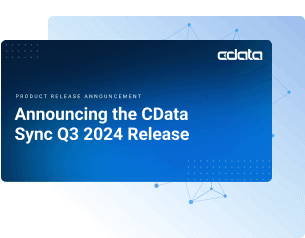New Reverse ETL Data Sources Expand Single-Platform Capabilities in CData Sync

Data teams are the heart of organizations’ information ecosystems, ensuring that data flows seamlessly from various sources into our data warehouses. But too often warehoused data can’t easily replicate back to business systems. This causes operations-focused colleagues in marketing, sales, and customer success to miss out on data insights that can provide a more complete picture than their single application.
Last January, CData launched initial reverse ETL (extract, transform, and load) features for CData Sync, enabling data replication from Snowflake and SQL Server into Salesforce. Now, with the CData Sync Q3 2024 product release, Sync users have the option to pull data from more warehouse sources — including Google BigQuery, Amazon Redshift, and PostgreSQL — into Salesforce.
Replicating warehoused data into Salesforce isn’t a new concept, but most frequently has been handled by dedicated software tools that don’t handle traditional ETL (replicating data into warehouses). Sync handles both traditional and reverse ETL processes, powered by our 300+ custom-engineered data connectors.
Why a unified ETL and reverse ETL platform matters
Combining ETL and reverse ETL in a single platform offers several advantages:
- Streamlined data integration: With both ETL and reverse ETL in one platform, the data integration process is simplified. This reduces the need for multiple tools and minimizes integration and team workflow complexities, allowing for a seamless data flow between systems.
- Improved data accuracy and consistency: Managing data transformations and synchronizations centrally ensures that data remains consistent and accurate across all systems. A single replication tool reduces the risk of discrepancies and errors, providing reliable data for decision-making.
- Enhanced near real-time data access: A combined ETL and reverse ETL solution facilitates near real-time data updates and access. This ensures that business applications and analytics tools always have the most up-to-date information, enabling timely decision-making.
- Cost efficiency: Using a single software product for both ETL and reverse ETL will be more cost-effective. It reduces the need for multiple licenses, maintenance, and training. In Sync’s case, the connection-based licensing offers scalability and predictability compared to the inherent fluctuations of usage-based licensing.
- Simplified data governance and compliance: Managing data transformations and movements within a single platform simplifies data governance and compliance. It provides better visibility and control over data flows, making it easier to ensure compliance with regulations and internal policies.
Empower non-technical users through self-service
CData’s streamlined, preconnected approach to building ETL and reverse ETL data pipelines is especially valuable for non-technical business users.
Some unified ETL/reverse ETL tools require users to define API endpoint requests with variables. This is certain to confuse and intimidate business users, tends to be tedious and error-prone, and introduces otherwise avoidable security risks with shared API keys and tokens.
With Sync, your data team can enable business-user data replication without added complexities, training, or time. Doing so can unlock many direct benefits to data engineers and database administrators, including:
- Business users can self-serve: In Sync, you can permission business users with read-only Operator roles, allowing them to run jobs, view job history, and download logs. This reduces the dependency on data engineering teams for routine data requests. This frees up engineers to focus on more complex and strategic tasks.
- Enhanced data utilization: Reverse ETL ensures that the data we manage is not just stored but actively used by various business units. This maximizes the value of the data and demonstrates the impact of our work on business outcomes.
- Improved collaboration: Reverse ETL fosters better collaboration between data engineering and other departments, such as marketing, sales, and customer support. When data is readily available in operational systems, it enhances cross-functional teamwork and aligns efforts toward ambitious business goals.
We have more details about common reverse ETL use cases and ways to drive business value in a previous blog post. The Sync product team is also actively working to expand our reverse ETL functionality, with support for additional CRM destinations coming soon.
Whether you need to host on-prem, in an Azure/AWS/GCP instance, or on the CData-hosted cloud, you can run a fully functional free trial of Sync to see how it works to replicate your warehouse data into Salesforce.
Already a CData user? Upgrade to the latest Sync version now to enhance your data integration and management capabilities!





